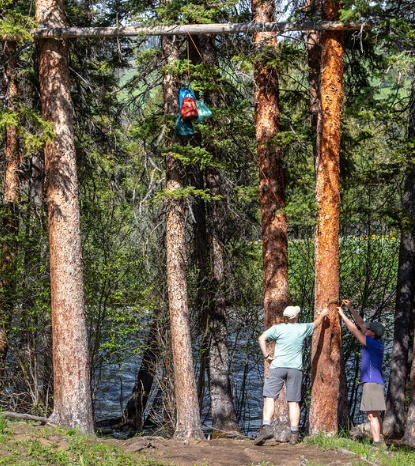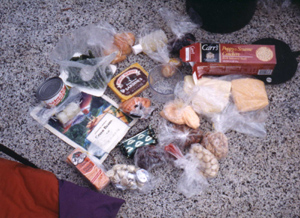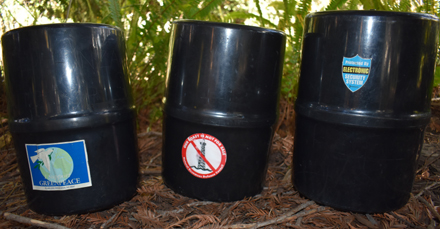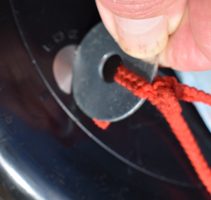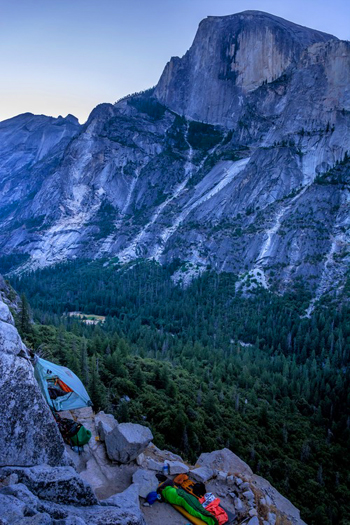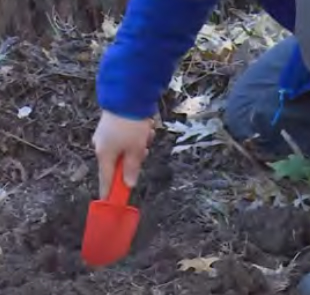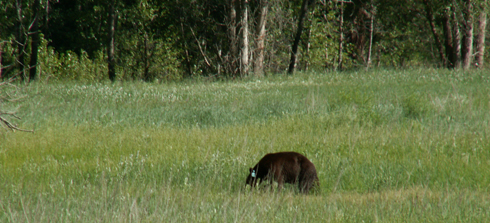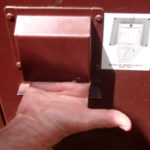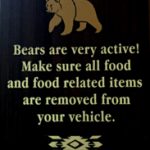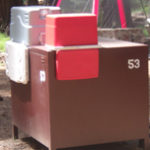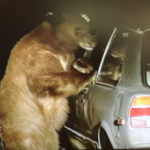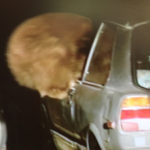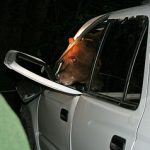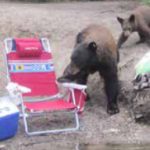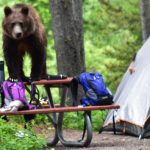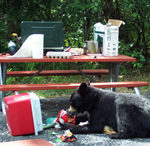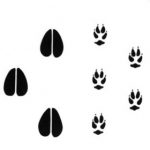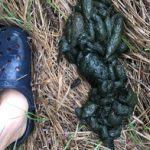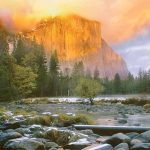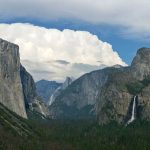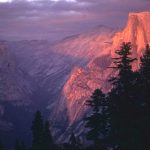Most parks/wilderness areas now require backcountry overnighters to use bear resistant food storage canisters (bear cans) instead of hanging food from trees. This can be because of bears, or some places along the coast especially, raccoons.
Some parks still have poles between two trees or between two other poles, in place in backcountry campsites for people to hang their food from:
The problem is that mama bear can teach a cub to climb up the tree, climb out on the pole, then jump down, snagging your bags of food.
And where hanging food is allowed, you can waste a lot of time trying to find just the right tree to hang things properly and you risk loosing your food if you do it wrong. Yosemite National park does not use this food protection system any more, and people traveling to / backpacking where it is allowed would be wise to use bear-proof backpacker sized food containers instead.
At some designated backcountry camping areas there are big metal bear boxes, but they don’t always have room in them for all the food/toiletries of the the potential users, or you would like your snacks handier when at the swim beach, so backpack sized food storage containers are a wise thing to use for all backcountry travel.
Check in advance of purchasing to see which brands of hard plastic models are okay where you go. Some bear resistant food containers made of Kevlar, fabric and/or fabric aluminum have been invented, but are not allowed at many parks.
Most parks that require them also rent them, some with a fee, many for free.
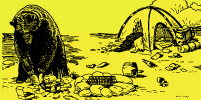
Note that they call these bear ‘resistant’ containers. It is especially not ‘bear proof’ if it is not closed and latched or latched improperly, or if you are not near it/your food and watchful when you have things out of it.
Everything you eat, including in seemingly strong packaging, such as canned tuna, must be in the container.
All toiletries (lotion, lip products, sunscreen, soap (body and dish soap), insect repellent, deodorant, feminine products, and medications) must be stored in the containers. When you re-pack sunscreen into a small container, please don’t skimp on the amount you pack.
These rules apply 24 hours a day, (except when you are actually using/cooking items) not just overnight. You might think you can leave some of the skin care items out handy in your pack all day, but if you forget and set the pack down while you take a restroom break, for example, various mammals can chew into your pack in seconds and some Ravens know how to get packs open. If all snacks are kept in the containers except when you are actually eating them you won’t forget to check all your pack/pants/shorts/jacket pockets and end up with food in your tent overnight, and your clothes won’t smell of the food. When we dayhike in some bear areas we keep the lunches/toiletries in a bear resistant container for the same reasons.
From The Yosemite Bear Facts (July 13 – July 19, 2003)
“Several bears continue to obtain food from backpackers in the Little Yosemite Valley area, including the Sunrise Creek and Moraine Dome area. One bear has learned to snatch backpacks containing food from unsuspecting hikers who have left their packs on the ground while pumping water or using the restroom. Another bear has learned to intimidate campers, snatching their open bear canisters if they show signs of backing down. It is important for backpackers and hikers to always be aware of their surroundings and to watch for sneaky bears.”
When we travel by canoe/kayak to backcountry sites with a designated big metal food storage locker for each site, we always bring at least one of the backpack sized containers so we can have snacks and/or one meal’s worth of food at the shore / beach. Then we can easily lock everything up if a swim or picture taking opportunity presents itself without having to carry everything back to the food storage locker.
Overnight, many locations recommend you keep the containers 100 feet downwind from your campsite sleeping area, and also recommend that you cook at least 100 feet downwind if there is no designated ‘campsite’.
If you store it near a slope/near a cliff it may roll away.
Stored near a waterway it can end up going downstream when a bear inspects it.
(And they will inspect it, and even drool on it.)
In a big group we keep track of which container is which by putting colored tape or stickers on them.
I have one with a sticker that says “Protected By ELECTRONIC Security System.”
A Ranger didn’t get the joke, do you think a bear will?
Tying a rope around it to make it easier to attach to your backpack also gives the bear a way to grip it with its teeth and walk away with it. An insulating cover can also make it easy for a bear to get away with it.
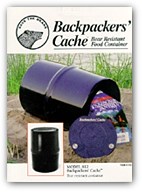
The De Anza College Outdoor Club uses Backpackers’ Cache bear resistant containers, by Garcia Machine.
Each are 8.8″ in diameter by 12″ long, and they fit inside most backpacks.
If packed efficiently (see advice on this below), it holds several days worth of food.
You open it by rotating the two latches with a coin, and pushing down on a button to remove the lid. (Don’t count on keeping track of where the one coin you use is, (and don’t count on not dropping it down between some rocks where you can’t retrieve it), store a spare quarter or two among your gear. Or sew/tie a washer about the size of a quarter on the cord of the bag you keep your dig-a-personal-latrine-trowel in.)
As of the info with the first one we bought in 2001 they recommend: “Keep it closed with both latches locked. Be prepared for uninvited guests. Keep it away from excessive heat, don’t use it as a stove stand. Store it away from the sleeping area. Do not attempt to retrieve a it while a bear is actively interested in it. A bear will fight for food. Let the bear paw, chew and kick the canister. He will lose interest in it and leave of his own free will.”
We do not have enough of these for everyone’s needs on a large trip, but enough that each person or couple can have one in advance of a trip to plan food packing. Then they can rent others in the park. The canisters can be rented at many locations in many parks that require them, such as entrance area information stations and retail stores.
You can fit more food in it if you remove excess packaging and cut out only the instructions and pack them with the food.
Don’t think you will remember how to make a meal without the instructions!
Pack toiletries into smaller containers. Cut a slice of deodorant off the stick and put it in a baggie. Use an almost worn out bar of soap. Squeeze an appropriate amount of toothpaste into a baggie. And again, when you re-pack sunscreen into a small container, please don’t skimp on the amount you pack.
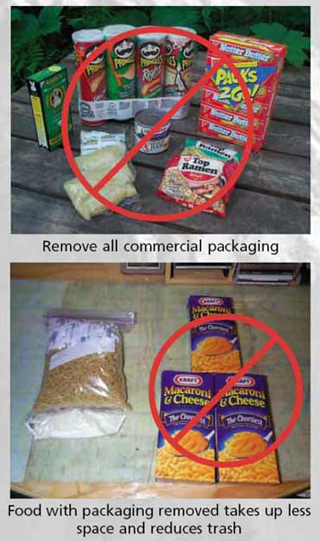
(The photo above from the Grand Teton webpage might seem to imply that you should empty canned tuna into some other container (zip-lock bag?) but think through whether you will be able to protect that wetness from leaking and whether the tuna will stay healthly to eat when opened and not refrigerated.)
Think through each meal. Pre-measure each ingredient. (If you bring a entire huge box of something you will not actually eat all of, you could end up with leftover spoiling food you think you want to bury rather than pack out.)
A meal based on tortillas takes less space than one based on big sandwich rolls. Likewise spaghetti takes less space than macaroni.
Leave instant soup and others in their original envelopes but don’t bring the boxes.
It will be easier to cook less if you decide you want less if you pre-measure instant potatoes into serving-size baggies instead of full-meal-sized portions (and put instructions with them).
If you use pre-made freeze dried meals they often come in inflated packages. For a short trip you might pin-prick them just before packing to let extra air out.
If each person in a large group brings ‘extra’ for everyone else, you carry too much weight, so communicate with each other on that subject.
Double bag at least the powdered items, if not everything, in good-quality plastic bags, not the giveaway ones from your grocer’s produce section.
Pack a complete list of what you brought so you don’t forget anything. Specifically list major ingredients like margarine/butter. The head cook and food packer may have planned two sticks (8 tablespoons) as ingredients in various main dishes and only one/half stick for ‘extra’ so it’s important that other cooks know how much to not use on popcorn.
One exception to the no-boxes-rule could be one for crackers to keep them from crumbling into bits.
Canned tuna in oil gives you more calories for the weight than canned tuna in water.
You might think you can use one less container or bring more stuff if you don’t pack the first night’s meal in the container. But if you arrive quite late and/or just can’t fathom cooking and eating any of your planned dinners, you can be left with more food than fits.
You can have great backpacking meals with no-cook foods. See GORP and hiking snacks
![]()
You might find that due to rodents, you want your food stored in one of these while climbing far above bears and raccoons, such as sleeping and dining on Dinner Ledge on Washington Column with perhaps the best dinner time view of Half Dome:
To truly be able to leave no trace and follow backcountry rules about camping the proper distance from a lake or digging your personal latrine hole the proper distance from water, etc., you will need to know how far 100 or 200 feet is.
Lay out a tape measure at home for 100 feet and walk it and count your paces.
How to poop in the woods has all the details.
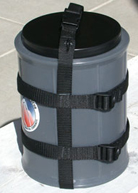 Where you must pack out your poop, using your food container is not a great idea. Clean Mountain Cans: http://www.nps.gov/dena/planyourvisit/cmc.htm
Where you must pack out your poop, using your food container is not a great idea. Clean Mountain Cans: http://www.nps.gov/dena/planyourvisit/cmc.htm
The Yosemite National Park rangers would like you to call them
if you see a bear in Yosemite,
no matter where it is or what it is doing.
Since 2003 there has been a note in the Yosemite Guide: “REPORT ALL BEAR SIGHTINGS! To report bear sightings, improper food storage, trash problems, and other bear-related problems, leave a message for the Bear Management team at: 1 (209) 372-0322. Your call can be made anonymously.”
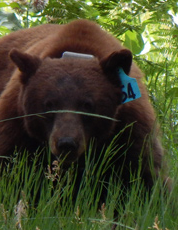
If you can, in all the excitement, try to notice if the bear has a tag (usually on the ear), the color of the tag and if possible, the number on it (the tag is large enough that with a telephoto lens you should be able to read the number).
From the Yosemite Daily Report newspaper:
“It is extremely important to remember to yell at bears that are in and around development, even if they are foraging on natural food. Though it is very tempting to get close for a picture, or just to watch these incredible animals, it is important not to give into this urge. Yelling at them if they are in residential areas or near people is critical to keep bears natural fear of humans. Giving bears plenty of space. When bears become too comfortable around people, they will often start causing damage to structures and vehicles, or will even become too bold around people, creating safety concerns.”
And the Yosemite Daily Report also said:
“Scare bears when you see them. . . in developed areas- Yell like you mean it!
Make as much noise as possible, try waving your arms, stomping your feet
or anything to make you look intimidating and to get the bear to run away.
We know it’s fun to see bears and it can feel mean to scare them,
but this is a simple way to truly help save a bear’s life.”



Incidents of bears obtaining human food in popular wilderness areas often occur at higher rates than elsewhere in parks. Wilderness areas exposures to human food may also cause bears to subsequently search for human food
in developed areas.
Think you can outwit the bears by using some other method or other bear resistant container design than the approved containers? If you try and fail it could mean the bear will keep on trying to get human food and may have to be put to death. Zoos don’t want them and when the park tries to relocate them they mostly come back to where they found easy human food sources, or die trying to.
Some places people are even warned to NOT stop and eat:
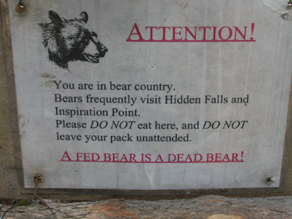
You need the containers at high altitude. Bears do not find natural food at high altitude, but having learned to get food from backpackers they now frequently roam there.
Bears are very smart animals. The ‘bear proof’ garbage bins have been redesigned many times by the park service. Bears have been used in circuses around the world because of their brains and gymnastic abilities. In backpacking areas some have been known to keep up the circus tradition by climbing on limbs above a suspended food bag and leaping to snag it with their claws on the way to the ground. Rock climbers report that bears pulled up food bags they hung over sheer rock cliffs. Bears don’t mind water and have swum out to a raft people thought they could hide food on.
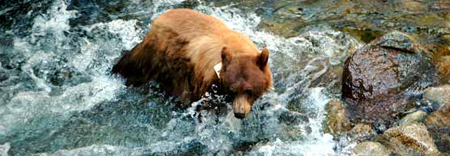

At the top of the stairs at the beginning of the portage trail from Leigh Lake to String Lake in Grand Teton park, and at the end of the portage trail as well, there’s a bear box (standard campsite metal footlocker style) with a sign on it reminding people to put all their food in it while they carry their canoe/kayak down the trail instead of leaving food sitting out unprotected.

On a trip a few years back in Grand Teton the rangers were prohibiting picnics in one popular area because a mom bear was teaching her cub to bluff charge picnickers to scare them away from their food.
Bears can get into locked rooftop car storage pods.
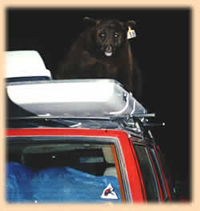
~Rangers do walk through backpack sites to check on things regularly; they can give out hefty fines for improper food storage, waste disposal or fires. They have even made people
without permits or with violations walk back out.
FAQ: Can I use repellents, etc. to keep bears or coyotes or … out of camp?
NO.
A bear may enter your campsite day or night, even in the presence of many people, large dog(s), a big campfire or lots of lights.
Running your vehicle engine or generator, playing loud music, trying various bear ‘repellents’
(mothballs, an open bleach container, dog or cat in-the-garden repellent, etc.)
will not work.
Yosemite noted: “You can place pots and pans on top of the bear resistant food storage container as a bear alarm if you like.”
It might not scare off the bear, but it could wake you up.
Setting your car alarm will not keep a bear from breaking into your car, it will just wake up everyone in the campground.
Leaving your dog in the car will not scare off the bear. One morning at the Yosemite Ahwahnee Hotel, a bellman found a car broken into by a bear the night before. An empty ice chest had been showing (and smelling to a bear) through the back window. The large family dog was cowering and whining under the steering wheel column.


Using a campsite food storage locker, gives you ideas on how to use a metal campsite food storage locker, including some logistics on sharing one in a large group.
At bears you will find:
links to general info about bears,
then practicalities of camping and backpacking around bears, (Food Storage , what to do if you see a bear, how bears get into cars, info for backpackers) and lots of stories about bears getting into cars, tents, camps, etc., mostly geared towards De Anza College Outdoor Club trips around bears in California (especially Yosemite National Park) and Grand Teton National Park.
And the answer to the question:
Why don’t the rangers just move the problem bears?
and the question:
How can I keep a bear out of my campsite? (You can’t, but you can almost always keep it out of your food.)
Also potentially of interest:
Backpacking Advice has these sections: Must bring for each large group (or perhaps for each couple or person), Must bring backpacking for each person, Some (crazy?) people think these are optional for backpacking, Backpacking luxuries(?), Do not bring these backpacking, To keep down on weight backpacking, Don’t rush out and buy, BACKBACKING FOOD, Low-cook backpacking foods, Yosemite National Park WILDERNESS PERMITS, Leave no trace camping has these basic principles.
First-timer’s instructions has instructions for beginning snow campers for the De Anza College Outdoor Club winter trip. Experienced people will probably pick up a few useful ideas.
Yosemite backpackers pages start at: http://www.nps.gov/yose/planyourvisit/backpacking.htm
Grand Teton backpacking advice includes note on carrying bear spray.
The day hike gear section at Camping equipment checklist
Thunderstorm and lightning safety includes the answer to the question: Why can’t you swim during a lightning storm? A strike on a lake doesn’t kill all the fish in the lake.
see also: Cell phones in the wilderness which has advice on how/when to use a cell phone to contact 911 in the wilderness and a warning about interference between cell phones, iPods and avalanche beacons.
 You can’t always expect a helicopter rescue
You can’t always expect a helicopter rescue
Can a person who is prescribed an epi-pen risk going into the wilderness? and some sting prevention notes are at: Anaphylaxis quick facts
Your safety in grizzly bear habitat
Hiking Advice has hot weather hiking advice, hiking logistics and the answer to the question: When is the best time of day to cross a mountain stream?
Camping solutions for women has tips for and answers typical questions from first-time women campers, including the question: Can menstruating women camp or backpack around bears?
Enhance your drive to your adventure: Road trip advice and etiquette
___________________________________
 Was that a black bear or a grizzly, a coyote or a wolf or a fox we just saw?
Was that a black bear or a grizzly, a coyote or a wolf or a fox we just saw?
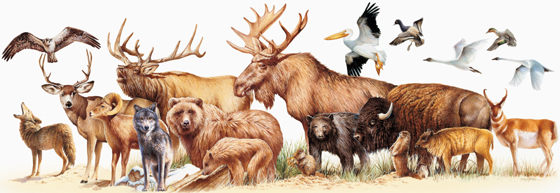 Rocky Mountain mammal size comparisons has photos and comparisons of beavers, squirrels, pika, marmot, elk, moose, bison, fox, coyote, wolf, golden-mantled ground squirrel, chipmunk, Red Squirrel (also known as) Chickaree, Unita Ground squirrels, bobcat, lynx, mountain lion (cougar), pine marten, mountain goats, bighorn sheep, pronghorn, grizzly and black bears, tundra swan, trumpeter swan, adult and juvenile Bald Eagles.
Rocky Mountain mammal size comparisons has photos and comparisons of beavers, squirrels, pika, marmot, elk, moose, bison, fox, coyote, wolf, golden-mantled ground squirrel, chipmunk, Red Squirrel (also known as) Chickaree, Unita Ground squirrels, bobcat, lynx, mountain lion (cougar), pine marten, mountain goats, bighorn sheep, pronghorn, grizzly and black bears, tundra swan, trumpeter swan, adult and juvenile Bald Eagles.
___________________________________
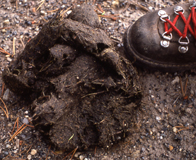 See also: animal sign comparisons
See also: animal sign comparisons
(how to use tracks and scat to distinguish species)
Please do not handle scat. Wolf scat, for example, can transmit tapeworm eggs to humans.
Watch a Grand Teton National park video identifying and comparing animal tracks
https://www.nps.gov/media/video/view.htm?id=2896C9FD-155D-451F-67912A1CB1362CCF
______________________________________
Where were they when they got that great picture in Yosemite?
Where can I take a photo that looks like the one on a Yosemite postcard I just bought?
Places to take photos of Half Dome, Bridalveil Fall, El Capitan, Yosemite Falls and Staircase Falls.
